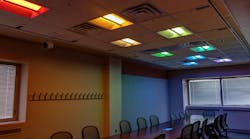The Smart Lighting Engineering Research Center (ERC) at Rensselaer Polytechnic Institute (RPI) developed, and subsequently delivered, its first inpatient testbed for monitoring the effects of LED lighting on psychological and neurological health. An addition to the inpatient sleep laboratories and sleep-medicine clinics at the University of New Mexico Health Center (UNMHC) in Albuquerque, the testbed will be used in clinical research led by a team from the University of New Mexico (UNM).
“Knowing more about the effects of lighting may actually help physicians prevent disease and increase productivity in healthy persons,” says Lee Brown, M.D., professor of internal medicine and director of the UNM Health Sciences Center’s Sleep Disorders Program.
The first experiment will study variations in light spectrum throughout the day and its influence on sleep behavior in patients with delayed sleep-wake phase disorder. Later experiments may focus on other circadian rhythm disorders, depression, and neurological disorders such as Parkinson’s disease.
The ERC’s fully automated and programmable lighting system can also be set to respond to stimuli, such as weather changes and sunlight, to provide light at different frequencies, spectra, intensities, and directions throughout the day. The system integrates feedback sensors to ensure that light settings remain correct during testing.
“At the ERC, we are building smart lighting systems that automatically adjust the right lighting for us at any given time, with light coming from the right direction, with the right color and intensity, optimized for human health and productivity,” says ERC Director Robert Karlicek.
Funded by the National Science Foundation, the ERC is an interdisciplinary, multi-university center with members from academia, industry, and government who work together to develop automated lighting systems. Smart lighting systems from the ERC are intended to reduce the carbon footprint of homes and offices, creating smart agricultural settings, finding innovative medical testing and procedures, and other applications.
